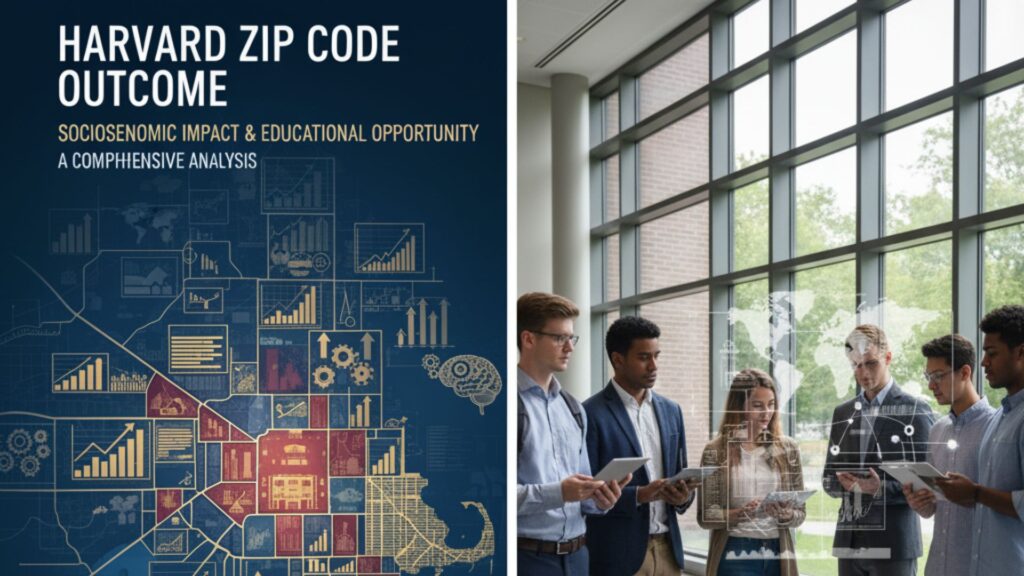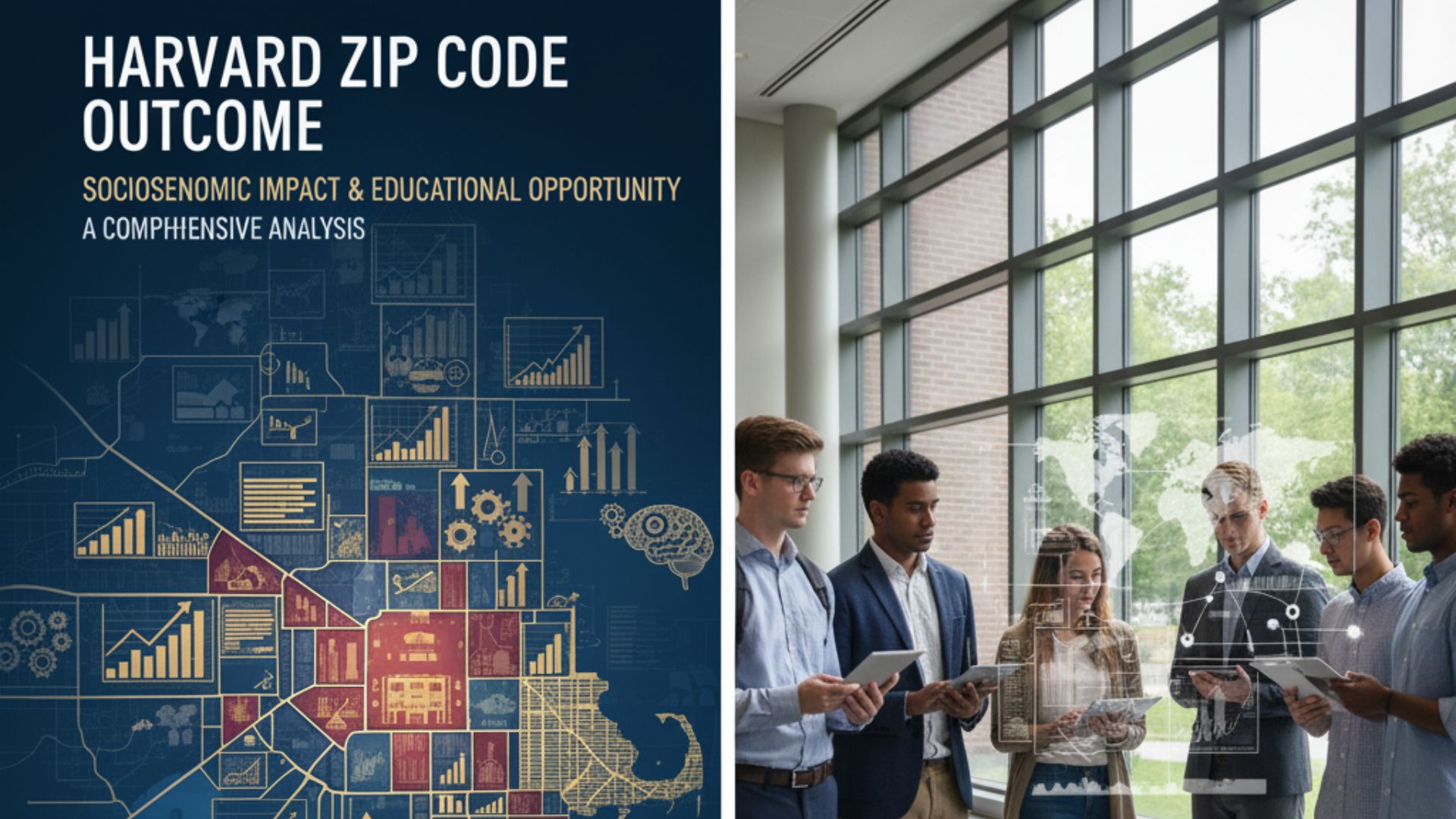Harvard zip code outcome: When people think of “Harvard,” they usually associate it with academic excellence, global influence, and intellectual prestige. However, in recent years, the term “Harvard Zip Code Outcome” has gained traction in discussions about education, inequality, and socioeconomic mobility in the United States. This concept refers to the analysis of how one’s zip code—essentially, the area or neighborhood where a person grows up—can significantly influence their likelihood of achieving success, particularly in gaining access to elite universities such as Harvard University.
In simple terms, the Harvard Zip Code Outcome explores the relationship between a person’s geographical background and their educational or career outcomes. It underscores how social and economic factors tied to location—such as access to quality schools, income levels, neighborhood safety, and community resources—play a decisive role in shaping future opportunities.

This article examines the meaning of the Harvard Zip Code Outcome, why it matters, the data behind it, and what it reveals about inequality in higher education. It also discusses what Harvard and similar institutions are doing to bridge these gaps and create a more equitable admissions landscape.
Understanding the Concept: What Is the Harvard Zip Code Outcome?
The Harvard Zip Code Outcome is not an official Harvard term but a concept derived from statistical and social research that studies the connection between zip codes and life outcomes. Researchers often use elite university admissions—especially Harvard University—as a benchmark for measuring upward mobility, opportunity access, and social inequality.
A person’s zip code can reveal much about their socioeconomic status. For example, students from affluent neighborhoods often have access to better schools, tutoring, extracurricular activities, and college preparation resources, all of which contribute to higher chances of being admitted to top-tier universities like Harvard.
In contrast, students from economically disadvantaged zip codes face limited educational opportunities, fewer academic resources, and sometimes unstable living conditions. This geographical inequality can result in significantly lower chances of entering elite institutions, regardless of talent or potential.
Why Zip Code Matters in Educational Outcomes
A zip code reflects more than just a location—it encapsulates a combination of social, economic, and environmental factors. These elements can directly affect an individual’s educational performance, health, and long-term prospects.
Here are key aspects explaining why zip code matters:
- Access to Quality Education
Wealthier areas typically have well-funded public schools, better teachers, and more advanced learning resources. In contrast, schools in lower-income neighborhoods often struggle with underfunding and overcrowding. - Parental Income and Support
Students from higher-income zip codes are more likely to have parents who can afford private schooling, SAT prep, extracurriculars, and academic counseling—all crucial for Harvard admissions. - Community Resources and Environment
Libraries, mentorship programs, and safe neighborhoods create an environment conducive to learning, whereas high-crime or resource-poor areas pose challenges that hinder academic focus. - Peer Influence and Social Capital
Being surrounded by ambitious peers and networks of professionals provides guidance, motivation, and mentorship—advantages that students from underserved zip codes often lack. - Health and Nutrition
A student’s physical and mental well-being also depend on their environment. Access to healthcare, clean air, and nutritious food influences cognitive performance and long-term health outcomes.
The Harvard Admissions Context
Harvard University receives over 60,000 applications annually, and only about 3–4% are admitted. The competition is fierce, but data shows that students from wealthier neighborhoods are disproportionately represented in these numbers.
Studies on the Harvard admissions process have revealed that a large percentage of accepted students come from the top income brackets. For instance, more than 40% of students at Harvard hail from families in the top 5% of income earners. Conversely, students from the bottom 20% of the income scale make up a very small portion of the admitted class.
This disparity is deeply tied to the zip code effect—where wealthier postal codes produce students who are statistically more likely to attend Harvard.
Analyzing Zip Code and Outcome Correlation
| Zip Code Type | Average Family Income (USD) | College Attendance Rate | Chance of Ivy League Admission | Average SAT Score Range |
|---|---|---|---|---|
| High-Income Urban (e.g., Manhattan, CA suburbs) | $180,000+ | 95% | 8–10% | 1450–1550 |
| Middle-Class Suburban | $80,000–120,000 | 80% | 3–5% | 1300–1450 |
| Rural Moderate-Income | $50,000–70,000 | 65% | 1–2% | 1200–1350 |
| Low-Income Urban | <$40,000 | 50% | <1% | 1050–1200 |
These statistics demonstrate that geographical inequality plays a major role in educational success, especially for institutions with selective admissions like Harvard.
The Harvard Perspective on Addressing Zip Code Inequality
Harvard University acknowledges the impact of socioeconomic inequality on education and has implemented several measures to ensure that zip code does not determine access to opportunity. Some of these initiatives include:
- Need-Blind Admissions
Harvard’s admissions process does not consider an applicant’s financial situation. Every applicant is evaluated solely on merit, achievements, and potential. - Generous Financial Aid Program
Harvard provides need-based aid that covers 100% of demonstrated financial need. Families earning less than $85,000 per year typically pay nothing toward tuition. - Outreach to Underserved Communities
Through programs like Harvard’s Undergraduate Minority Recruitment Program (UMRP) and partnerships with nonprofits, the university engages high-potential students from underrepresented zip codes. - Research on Equality of Opportunity
Harvard researchers have contributed to major studies like the Opportunity Atlas, which map how neighborhoods influence economic mobility across the United States. - Holistic Admissions Review
Beyond grades and test scores, Harvard considers personal essays, background, life experiences, and overcoming adversity as significant parts of the admissions decision.
The Broader Impact: Opportunity Atlas and Harvard Research
One of the most influential studies related to the Harvard Zip Code Outcome was conducted by Harvard economist Raj Chetty and his team at the Harvard Opportunity Insights Lab. Their research revealed that children’s outcomes are strongly linked to the zip codes they grow up in.
For example, a child from a high-mobility area (with good schools and low crime) has a much higher chance of achieving economic success than a child from a low-mobility neighborhood. The research emphasizes that improving neighborhood environments can directly increase social mobility and educational outcomes.
This study led to the creation of The Opportunity Atlas, a public tool that shows how each neighborhood in America affects future earnings, education, and social outcomes.
What Can Be Done to Improve the Harvard Zip Code Outcome?
Bridging the zip code gap requires both systemic and institutional action. Harvard and other universities, along with policymakers and communities, can focus on:
- Improving K-12 Education Access
Invest in quality education in underserved areas to create a fair starting point for all students. - Expanding Outreach Programs
Identify talented students early, regardless of zip code, and provide mentorship and resources to prepare them for top universities. - Reducing the Standardized Test Gap
Provide free or subsidized test preparation resources for students in underprivileged zip codes. - Enhancing Community Infrastructure
Safe environments, community centers, and access to technology foster learning and development. - Encouraging Local Scholarships and Grants
Partnerships between universities and local governments can support students from specific areas with high potential but low opportunity.
Important Links and Information
| Category | Description | Link / Source |
|---|---|---|
| Harvard University Official Website | Main website for Harvard University | https://www.harvard.edu |
| Harvard College Admissions | Learn about undergraduate admissions and policies | https://college.harvard.edu/admissions |
| Harvard Financial Aid Office | Information on scholarships and need-based aid | https://college.harvard.edu/financial-aid |
| Opportunity Insights (Harvard Research Lab) | Research on economic mobility and opportunity by Raj Chetty | https://opportunityinsights.org |
| The Opportunity Atlas | Tool mapping neighborhood impact on life outcomes | https://opportunityatlas.org |
| Harvard Outreach Programs | Initiatives for underrepresented students | https://college.harvard.edu/academic-life/diversity-inclusion |
Case Studies: Real-Life Zip Code Outcomes
Case 1: A Tale of Two Neighborhoods
Two students—one from a wealthy Boston suburb and another from an inner-city area—both dream of attending Harvard. While both are talented, the suburban student benefits from top-tier schools and mentorship programs, while the inner-city student struggles with limited access to resources. Despite equal potential, the suburban student statistically stands a better chance of being admitted, illustrating the powerful role of zip code.
Case 2: Overcoming the Odds
Harvard also showcases inspiring stories of students who beat the zip code odds. Many first-generation college students from low-income backgrounds have achieved admission through determination and support from outreach programs.
FAQ about Harvard zip code outcome
What does “Harvard Zip Code Outcome” mean?
It refers to how a person’s geographical location (zip code) affects their educational and economic opportunities, specifically in gaining access to elite institutions like Harvard.
Does Harvard consider zip code in its admissions process?
While Harvard does not directly consider zip code, it evaluates personal background, challenges overcome, and life context as part of its holistic admissions approach.
How does Harvard support students from disadvantaged zip codes?
Harvard offers need-blind admissions, generous financial aid, and outreach programs to identify and support talented students from underserved communities.
Are there studies that link zip codes to life outcomes?
Yes. Research from Harvard’s Opportunity Insights Lab, particularly “The Opportunity Atlas,” demonstrates a strong correlation between neighborhood environments and economic mobility.
Can changing neighborhoods improve outcomes?
Yes. Studies show that children who move from low-opportunity to high-opportunity areas at a young age often experience better educational and financial outcomes as adults.
What percentage of Harvard students come from low-income families?
Although the number is increasing, a smaller percentage of students come from the bottom 20% of income levels compared to those from the top 5%.
What is Harvard doing to make admissions more equitable?
Harvard has expanded need-based aid, strengthened recruitment efforts in underrepresented regions, and supported research initiatives focused on opportunity and mobility.
Conclusion
The Harvard Zip Code Outcome is a compelling lens through which to examine the intersection of geography, education, and opportunity in America. It highlights the uncomfortable truth that where you grow up can significantly influence where you end up in life. Harvard University, as one of the world’s most influential educational institutions, plays a critical role in addressing this imbalance through its need-blind admissions, financial aid, and research-driven social initiatives.
However, lasting change requires collective action—from governments, educators, and communities—to ensure that a child’s future is not predetermined by their zip code. True equality of opportunity means that every talented student, regardless of background, has a fair chance to reach their full potential.
The Harvard Zip Code Outcome reminds us that the pursuit of excellence should always be accompanied by a commitment to equity—and that education remains the most powerful tool to bridge that gap.

